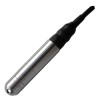Click save settings to reload page with unique web page address for bookmarking and sharing the current tool settings
Change the answer mode for this tool by selecting V1 gas volume, T1 gas temperature, V2 gas volume or T2 gas temperature as the parameter to calculate instead
 32…212°F Temperature Range Sensor with 4-20mA Current Output Signal Transmitter
32…212°F Temperature Range Sensor with 4-20mA Current Output Signal Transmitter 32…122°F Temperature Range Sensor with 4-20mA Current Output Signal Transmitter
32…122°F Temperature Range Sensor with 4-20mA Current Output Signal Transmitter RS485 submersible wastewater level and temperature sensor for 3 metre depth
RS485 submersible wastewater level and temperature sensor for 3 metre depth Temperature Measuring Submersible Sensors and Instruments
Temperature Measuring Submersible Sensors and Instruments
Related Tools
- Ideal gas law calculator
- Boyle’s law calculator
- Avogadro’s law calculator
- Gay-Lussac’s law calculator
- Combined gas law calculator
- Volume units conversion
- Temperature units conversion
User Guide
This tool will calculate any parameter from the equation defined by Charles’ law V₁/T₁=V₂/T₂, which includes the V1 gas volume, T1 gas temperature, V2 gas volume and T2 gas temperature.
Charles’ law explains that for an ideal gas, the volume of the gas is directly proportional to the temperature of the gas, as long as the pressure and quantity of gas is unchanged.
Formulas
Charles’ Law is explained with math in the following ways.
The volume of an ideal gas is proportional to its temperature:
V ∝ T
The Volume divided by the temperature of the gas in a given state, equals a constant value:
V / T = Constant
The division of volume by temperature for an ideal gas in one state, equals the division of volume by temperature for an ideal gas in another state, as long as the pressure and quantity of gas does not change between the two states.
V1 / T1 = V2 / T2
The formulas used by this Charles’ law calculator to determine each individual parameter are:
V1 = V2 · T1 / T2
T1 = T2 · V1 / V2
V2 = V1 · T2 / T1
T2 = T1 · V2 / V1
Symbols
- V1 = Volume of the first gas state
- T1 = Temperature of the first gas state
- V2 = Volume of the second gas state
- T2 = Temperature of the second gas state
V1
This is the total volume occupied by the first gas state.
T1
This is the temperature of the first gas state.
V2
This is the total volume occupied by the second gas state.
T2
This is the temperature of the second gas state.
 Temperature Measuring Submersible Sensors and Instruments
Temperature Measuring Submersible Sensors and Instruments ProSens Environmental Monitor and Controller
ProSens Environmental Monitor and Controller Climate room over/under pressure, temperature & RH monitor & controller
Climate room over/under pressure, temperature & RH monitor & controller 200cm range 0-5Vdc output submersible road flood stream depth and PT1000 sensor
200cm range 0-5Vdc output submersible road flood stream depth and PT1000 sensor
